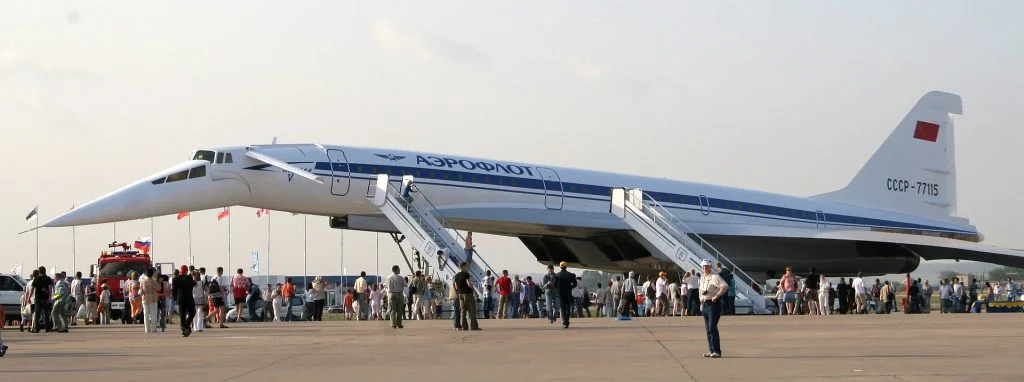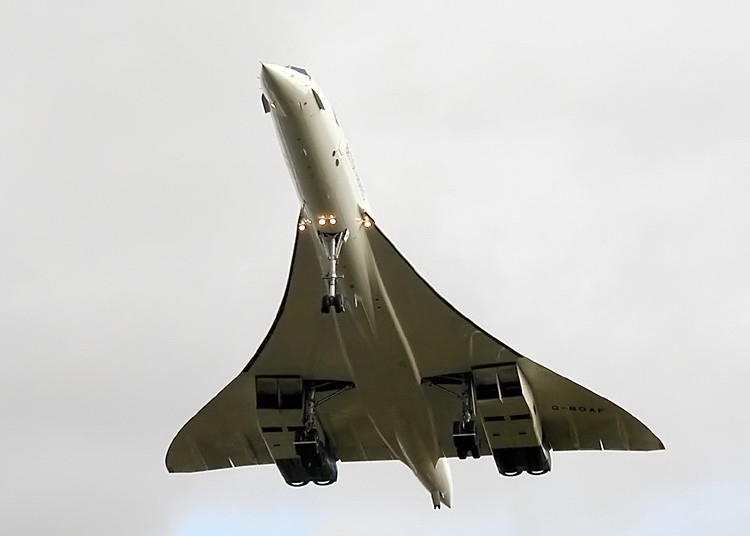Contrary to popular belief, the beloved Concorde was not the first supersonic airliner to take flight. The Soviet Tupolev Tu-144 beat it to the skies by 2 months and 3 days.
While both the Concorde and Tu-144 are marvels of engineering, the Soviet approach to tackling the challenges of supersonic air travel was notably more brute-force.
To the untrained eye, the two aircraft look almost identical, with long, slender fuselages, large delta wings, and drooping noses known as “droop snoots.” In fact, the resemblance is so striking that many have accused the Soviet Union of copying the European design.
Due to their similarities in design and performance, the Tu-144 is forever linked to the Concorde, earning the unofficial nicknames ‘Russian Concorde’ and ‘Concordski.’
In the 1960s, while competing with the US in the Space Race, the Soviets became aware of the British-French collaborative effort to produce a supersonic passenger airliner. This monumental task was globally recognized as a marvel of engineering, science, and technology.
But it wasn’t just Europe with plans to build such a machine; the United States was giving it their own go with the SST project.
Officials in Moscow, desperate to showcase the benefits of communism, knew that building their own supersonic airliner would prove their perceived technical superiority to the world.

In 1963, the Soviet government greenlit an aircraft to rival the British-French project – its name was the Tu-144. However, this Herculean task quickly proved to be too much for the Soviets, who were simultaneously battling the Space Race, developing a large land army, and perfecting intercontinental ballistic missiles. But if Soviet leadership demanded a supersonic airliner, a supersonic airliner they would get!
Unfortunately, significant technological problems quickly presented themselves, and it soon became clear that the Tu-144 wasn’t going to be as sleek, smooth, or refined as its European counterpart.
The Tu-144’s Extreme Design
To fly passengers faster than the speed of sound, both designs faced immense technological hurdles. The Concorde team solved these methodically with pioneering breakthroughs, such as carbon fiber brakes for landing and computerized systems that continuously adjusted the engine inlets and wing shape during flight to maintain efficiency.

The Tu-144, however, relied on more conventional practices and brute force to solve the same problems. Considering this, it is incredible that the Soviets managed to build an aircraft that was as close as it was to the Concorde.
The Tu-144 was a massive aircraft with a maximum take-off weight of 220 tons – 22 tons more than the Concorde. Its wings were 30 percent larger in surface area, and the fuselage was 4 meters longer.
Due to the extra weight, the Tu-144 needed more power. Four Kuznetsov NK-144 afterburning turbofan engines powered the massive aircraft into the sky. On full afterburner, each of the 5-meter-long engines provided 40,000 lbs of thrust, more than the Concorde’s Rolls-Royce Olympus engines. Later versions were powered by Kolesov RD-36-51A turbojets, which produced 44,000 lbs (20,000 kg) of thrust each.
This resulted in an aircraft that was actually faster than the Concorde, with the Tu-144 topping out at 1,550 mph (depending on the variant), compared to the Concorde’s top speed of 1,350 mph.
Wing Design Challenges
One of the most crucial problems facing designers was the shape of the wing. Different wings are suited to different conditions, but in the case of a supersonic airliner, they had to work as well at twice the speed of sound as they did while coming in to land.

Both aircraft made use of a triangular delta wing, which increases an aircraft’s high-speed performance. However, at low speeds, delta wings suffer from a lack of lift, requiring fast take-offs and landings at high angles of attack. Concorde’s designers put major emphasis on perfecting its wing, critical to the aircraft’s performance at both high and low speeds.

They discovered that a longer delta wing increases low-speed lift. Consequently, they extended the Concorde’s wing along almost the entire fuselage. Its distinctive and complex “ogee” shape allowed Concorde to maintain lift at varying angles of attack while keeping the correct center of gravity at landing speeds.
The Tu-144 had a similarly shaped wing, but it was more angular and much less refined than the British-French design. This meant the Tu-144’s low-speed performance was poor, requiring canard wings above the cockpit to increase frontal lift.

It had a high landing speed of 207 mph – almost 30 mph faster than the Concorde – and needed a landing parachute. Despite its shortcomings, the Tu-144 managed to beat the Concorde to the air, flying for the first time on December 31, 1968 – three months before Concorde.
It then broke the sound barrier on June 5, 1969 – four months before Concorde. The aircraft may have achieved flying status before the Concorde, but was this really the win the Soviets thought it was? Unfortunately, it seems not. Its rushed development would haunt the aircraft for the rest of its service life.
A Rough Start
Before it had even entered service, a Tu-144 suffered a horrific crash at the 1973 Paris Air Show. The aircraft came in as if to land, then applied full throttle and nosed up into a steep climb. The Tu-144 then appeared to lose power before nosing down into a dive. At around 700 ft, it tore apart. The bulk of the wreckage landed on a small village, killing eight people. All six crewmen on board were lost.

The exact cause of this accident is still unclear. It’s known that the crew was instructed to outdo the Concorde’s display and deviated from their planned routine. The crew likely pushed the airframe past its limits to outdo the Concorde, causing it to stall and lose control.
The event has generated many theories over the decades since. What is for sure is that the aircraft’s reputation was severely damaged.
The Tu-144’s Turbulent Service
The Tu-144 entered service delivering freight in 1975. When it entered passenger service in 1977, the Tu-144 had less than 800 hours of flight testing. The Concorde had 5,000. The airframe was rushed and unsafe, and the Soviets knew it.
Even on its first passenger flight, it had poorly fitted interior panels, some reading lights didn’t work, not all toilets worked, and window sun shades would drop on their own. A faulty passenger ramp then delayed the flight by 30 minutes.
During supersonic flight, passengers were subject to over 90 decibels of noise inside the cabin – around the same volume as a lawn mower. This was because the Tu-144 could only sustain supersonic speeds with its thunderous afterburners ignited.
Passengers could just about maintain a conversation when sat side by side. Hilariously, passengers sat more than two seats apart were unable to hear each other even when screaming. To communicate, they had to pass around handwritten notes.
On a flight in 1978, Tu-144 Pilot Aleksandr Lerin recalls when his aircraft had seven to eight onboard system failures while still on the runway. Officials instructed him to continue on to save embarrassment as there was Western media onboard.
In flight, a further 15 systems failed. Tupolev predicted only one landing gear would lower, requiring an emergency belly landing at the destination. The potential international reaction meant even Soviet Premier Leonid Brezhnev was personally involved in the situation. Luckily, the landing gear successfully deployed and the aircraft landed safely.
Tupolev acknowledged the Tu-144’s issues and promised to solve them. But unfortunately, this wasn’t to be. As proof of the lack of faith the Soviets had in the plane, Tu-144s only flew passengers on one route between Moscow, Russia, and Almaty, Kazakhstan.
The Tu-144 only flew a total of 55 passenger flights, with an average of 58 people on board. The aircraft could hold 140 people, but it is believed the amounts were reduced to limit the potential “damage” if an aircraft did crash. The aircraft stayed in service only to save the embarrassment of withdrawing it.
Tu-144’s Retirement
On June 1, 1978, it was retired from airline service after officials finally accepted the danger the Tu-144 posed to its passengers. It continued flying until 1983 as a freight transporter.
It is now clear that the aircraft was never safe to fly and should never have done so, especially as a commercial airliner. The rush to beat the Concorde meant the airframe was crude and unfinished. It is incredibly lucky there weren’t more Tu-144 accidents.

There is no doubt that with the right amount of time, Soviet engineers could have created a genuine equal to the Concorde. Unfortunately, as is so common with stories from the Soviet Union, meddling officials forced an untested, unready, and unsafe aircraft into the air, in hopes of proving the superiority of the communist system.
Specifications
- Crew: 3
- Passengers: 150
- Length: 65.7 m (215 ft 5 in)
- Wingspan: 28.8 m (94 ft 4 in)
- Height: 12.55 m (41 ft 2 in)
- Empty weight: 99,200 kg (218,699 lb)
- Max takeoff weight: 207,000 kg (456,356 lb)
- Powerplant: 4 × Kolesov RD-36-51 turb